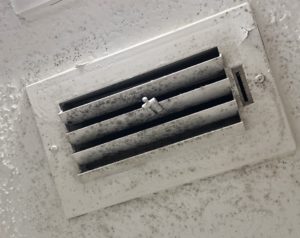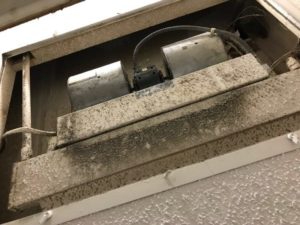A certain amount of anxiety comes up for parents when sending kids off to college. We worry if they will make healthy and safe choices, if they will be ready for the academic pressures and if they will find a good group of friends.
People typically think of mold as a problem in homes, especially in humid climates or after flooding, but apartments and shared housing are even more likely to be a source of mold toxicity.
If mold is in one apartment, for example, it can easily spread to others through the heating and air conditioning units or shared walls. Apartments tend to be tighter spaces, and perhaps aren’t cared for to the degree we would like.
Oftentimes, college students and their parents have to make quick decisions in hot campus rental markets in order to obtain housing.
We might make decisions to secure a place to live without fully looking into all of the details and it can often be tricky to navigate getting out of a lease when issues such as mold arise.
In the past few weeks, I’ve been involved in several cases of toxic mold in college campus housing. I’ve been called to help my niece and two separate members of my team identify the cause of their children’s symptoms as well as make the moves to get into new and safe living situations.
Unfortunately, this is not a new scenario as this issue has come up with many patients. From my perspective, mold toxicity on college campuses is truly an epidemic.
Symptoms of Mold Exposure and Mold Toxicity
After only a few hours in her daughter’s new college apartment, Susan, her daughter, her roommate and her roommate’s parents started to experience headaches and sinus pressure.
Susan’s daughter also had a stomachache. After a little exploration, they found black mold that was clearly visible around the air vents in the bathrooms and in the closets.
Under more close inspection, the air condition unit was covered with mold, which blows mold spores and toxins throughout the apartment contaminating all surfaces.
Obviously, this presented an unsafe environment for Susan’s daughter and her roommate. Fortunately for them, they identified the issue quickly and avoided the longer-term consequences that can arise.
Toxic mold releases mycotoxins and mVOC’s. Exposures to these toxins result in numerous symptoms affecting many systems in the body. It’s important to note that symptoms from mold exposure are cumulative, meaning that it builds up over time.
Some people are more sensitive and will experience symptoms at lower exposure levels and before others.
Given the fact that Susan and four others experienced symptoms within a few hours, it’s likely that levels were high, but take note that some may not experience symptoms until days, weeks, months, or years after moving into a new place.
Common symptoms from mold toxicity include:
- Decreased memory
- Difficulty concentrating
- Filling withdrawn, anxious, or depressed
- Headaches
- Visual change
- Insomnia
- Reduced immunity
- Decreased stress tolerance
- Nausea, abdominal discomfort
- Muscle pain, cramps, fasciculations
- Hair loss
- Night sweats
- And many more
Mold toxicity makes learning and retaining new information hard, which of course is incredibly important in a college setting.
Beyond these symptoms, mold may cause serious respiratory illness, including asthma, pneumonia, fevers, inflammation or CIRS, chronic inflammatory response syndrome.
Living in a moldy apartment or dormitory and then getting sick from COVID-19 and may even contribute to Post or Long-COVID Syndrome making recovery more challenging.
How To Spot Mold
If these symptoms have you thinking that mold might be contributing to your symptoms or health issues, the number one thing to do is to test – you can test the environment for toxic mold as well as test your body.
Just because mold is visible, doesn’t necessarily mean it is the type of mold that produces mycotoxins and conversely, it is possible to have toxic mold present, but it is hidden away.
Click here for my handout “Could it be Mold?”
Here are some tips for checking out your new apartment, dorm or other rental:
- Check vents for black spots, mold and cleanliness
- Check air conditioning units and HVAC vents
- Check around windows and doors
- Check in the fridge, freezer, dishwasher and washing machine
- Check bathrooms for changes in paint and tiles and cabinets
- If the room or apartment is furnished, be sure to check upholstery, curtains and carpet
- If anything looks black or dirty look into further
- Take pictures of everything as documentation
- Get your space tested for mold
- It is important to do dust sampling to get accurate results. Don’t trust the property management company to do this properly. One company I like is blackmoldscan.com. More info on my handout “Could it be Mold?”
- Clean up any water spills or leaks immediately and report damage to the landlord. Dry wall, wood and carpet must be dried in 24-48 hours to prevent mold.
Wherever moisture enters an apartment or stays in is a place where mold might be able to grow. Read my recent article Surprising Places You Might Find Mold for more tips on this topic.
If you can check out the space for mold before you move in, you’ll likely save yourself a lot of time, money and headaches (and possibly physical headaches too). But, if that isn’t possible, here is what you can do to get out of a rental.
What Can You Do To Get Out Of A Moldy Rental
First, it’s important to know the laws in your state. In Texas, the law requires that rental units must be habitable. This means that the landlord has the responsibility to remove any dangers in the property that make it “uninhabitable or harmful to human health and safety.” As the tenant in Texas, the landlord is required to remediate or let you out of your lease.
It is important to have the mold remediated with experts that set up containment and follow a detailed remediation plan. Be sure to document all communication with your landlord.
Other states might be more landlord-friendly so be sure to know what you are up against and the actions you need to take.
From recent experience navigating this situation with my niece and the experience of my team members, it is important to work with the highest person in charge, document all communication, and be persistent.
Luckily, in the case of Susan’s daughter, the photographs of the mold were enough to get them out of the lease and they were able to move into a new safe space.
Support Your Health After Mold Exposure
While initially, the first step is to get out of the environment that has the toxic mold in order to stop the exposure. However, for many that may not be enough to effectively stop the symptoms and fully heal the body.
In addition, I recommend following a clean, Paleo diet because one of the ways we are exposed to mold and toxins is through food. The next step is to support the body’s detoxification systems. It’s possible that you have factors that made you more susceptible to mold-related illness such as epigenetic, methylation, infections or other underlying factors.
It may be helpful to explore all of these pieces, heal the gut and address other imbalances.
I often recommend several simple supplements to support the detoxification pathways and boost immunity during and after mold exposure. Here are a few of my favorites:
- Clear and Restore Bath – A main way that toxins leave the body is through the skin! This detoxification bath combines dead sea salt, mineralized red algae, minerals, detoxification herbs and gentle essential oils to deeply cleanse and relax the body.
- Paleo Detox Protein – More than a protein powder and more than a meal replacement, this detox protein provides all of the vitamins, minerals, amino acids and antioxidants to support both Phase 1 and Phase 2 liver detoxification. In essence, it supports what your body does best, neutralizing toxins and getting them out of the body. It also tastes great!
- Exceed Greens + Reds Organic Superfood Powder – This delicious powder is an antioxidant powerhouse that protects cells from the damage caused by toxins as well as supports the detoxification systems. Fiber, polyphenols, probiotics and digestive enzymes support a balanced and healthy microbiome and helps to eliminate toxins through the digestive system.
- Children’s Immune Support Bundle – For my patients who don’t like swallowing pills, this is an effective immune support combining a multivitamin, probiotic, vitamin C and vitamin D.
- Mold Recovery Kit – This bundle includes a few hard-hitting detoxification supplements including liposomal glutathione and Toxin Clear, along with a laundry additive for washing mold spores out of clothing, bedding and other fabrics and an effective (and safe) cleaning solution for cleaning mold-contaminated surfaces.
We know that mold exposure impacts learning, immunity and overall health. Mold is the last thing our children need when embarking on their college journey.
While many college goers may be living at home, there are a lot who will be staying in dorms, apartments and other rentals.
It’s important to be vigilant about hidden water damage and mold when deciding where to live, and if toxic mold is discovered later, getting out of the unhealthy situation quickly and supporting the body’s recovery.
The following pictures are from one of the college apartments.
More Resources:
Download my “Could it Be Mold?” factsheet
References
- Miranda, M. L., Galeano, M. A., Hale, B., & Thomann, W. R. (2011). Crawl spaces as reservoirs for transmission of mold to the livable part of the home environment. Reviews on environmental health, 26(3), 205–213. https://doi.org/10.1515/reveh.2011.028
- Fung, F., & Hughson, W. G. (2008). The fundamentals of mold-related illness: when to suspect the environment is making a patient sick. Postgraduate medicine, 120(1), 80–84. https://doi.org/10.3810/pgm.2008.04.1764
- Hope J. (2013). A review of the mechanism of injury and treatment approaches for illness resulting from exposure to water-damaged buildings, mold, and mycotoxins. TheScientificWorldJournal, 2013, 767482.
- Pizzorno, Joseph, and Ann Shippy, MD. “Is Mold Toxicity Really a Problem for Our Patients? Part 2-Nonrespiratory Conditions.” Integrative Medicine (Encinitas, Calif.), InnoVision Professional Media, June 2016.
















